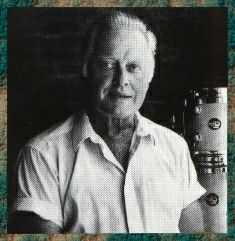the
page dedicated to mr. JIM
CHAPIN
I've met Jim Chapin
in Los Angeles, 1995. He's a nice and friendly guy, and indeed a very great
drum performer, an incredible unforgetable hands technique. And he always
like to talk about drumming.
We have a little
conversation, he also teach me his hands technique, realize that it takes time
and experience to do such thing. The first step had to be taken to get the next.
He inspired me much about how to behave as a drummer, a musician.
Here's some information about him :
Jim Chapin was
born in New York City in 1919. His father was James Ormsbee Chapin, an artist
of the American Scene style of painting and his mother was Abigail Furbei Chapin,
a teacher and writer. He did not begin playing the drums until he was 18 years
old, after being inspired by legendary drummer, Gene Krupa. Jim studied with
Sanford Mueller, upon the advice of Krupa, and within a short time he was playing
opposite Gene at the 1939 World’s Fair in New York City.
In the early 1940s,
Jim began working on a drum instruction book that was eventually published in
1948 as Advanced Techniques for the Modern Drummer, volume
1, Coordinated Independence as Applied to Jazz
and Be-bop. Shortly thereaftcr, Jim had to have a pair of drum sticks
in his back pocket at all times in case he was called upon to demonstrate a
particularly difficult passage and to prove that he truly could play every pattern
in the book! Advanced Techniques, which is now known simply as ”The Chapin Book”,
became the most important drum set text ever written and is still in print today.
It was recognized in 1993 by Modern Drummer magazine as one of the top 25 drum
books of all time All of the great drummers in the past nearly 50 years have
paid their dues with this book that is the much-imitated, standard work on the
subject. In 1971, Jim published Advanced Techniques for
the Modern Drummer volume II, Independendce – the open end. a monumental
undertaking that utilizes overlays to illustrate its complex points. In the
preface of this work, Jim admits that even he cannot play every pattern that
is presented, thus getting him off the hook of having to pull out his sticks
on demand to prove that everything printed can actually be played. Volume II
was ahead of its time 30 years ago and is modern today.
From the 1940s
through the 1960s, Jim performed and toured with a variety of hands. including
Glen Gray and the Casa Loma Orchestra and groups led by the likes of Mike Riley.
Woody Herman, Tommy Dorsey and Tony Pastor. He also performed on occasion with
his sons, Tom, Steve and the late Harry Chapin who was one of top singer-songwriters
of 1970s and a founding member of the World Hunger Year. And he has led his
own groups for the past 20 year.
In the early 1960,
Jim wrote a musical play entitled ”Passing Fair”. Unfortunately, the interracial
themes of the production did not jibe with the racial climate in the country
at the time and the work never produced. However, two of the songs presented
later on his compact disc by HQ, made on 1994 (”Carny Days” and ”Love And Laughter”)
are from the play.
In the past 10
years, Jim has found a second career, as he has been ”discovered” by a new generation
of musicians that hunger for the dcpth of knowledge he possesses on drummers
and drumming. He spends the majority of his time traveling around the world
teaching and presenting seminars and he is a fixture at music trade shows and
percussion conventions. In 1994, he received two honors for his contributions
to music and education. One was the American Eagle Award, presented by the National
Music Council and the other was bestowed by the Berklee College of Music.
Because of his
staying power. Jim is taken for granted. Through times of ”here today-gone tomorrow”
artist, he has always been there. During the past 55 years, he has observed,
studied and analyzed every great (and not so great) drummer. He was there almost
from the beginning of modern drum set playing and that will never happen again.
He is a master student in addition to being a master teacher and at, 75 years
of age, Jim epitomizes the most important quality necessary for longevity in
the music business: he will not grow old!
